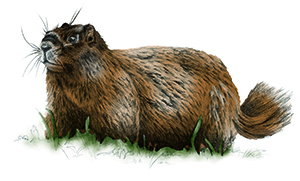Home → Fish & Wildlife → Wildlife → Species Information → Mammals → Woodchuck
Woodchuck
Marmota monax
On this page:

Other Common Names
Groundhog
Habitat
Open grassy areas, fields, small open woodlots, agricultural land, and along brushy fence lines, where they make underground burrows, often on slight hills, up to five feet deep and 30 feet long. These burrows, when abandoned, provide denning sites for opossums, raccoons, foxes, and skunks.
Diet
This herbivore eats grasses, dandelions, clover, and garden crops.
Distinctive Characteristics
About two feet long, this largest member of the squirrel family has dark gray fur on a stout body with short legs and tail, and gives a sharp whistle as an alarm call.
Nocturnal/Diurnal
Most active during the mornings and evenings of warmer months.
Seasonal Changes
A true hibernator, the groundhog’s body temperature drops from 97 to 40 degrees for up to six months; only males come above ground in late winter to mate and then go back into hibernation.
Reproduction & Family Structure
Two to five young are born in late spring, in a single litter.
Living with Wildlife
How to Prevent or Resolve Conflicts with Woodchucks
Woodchucks may eat plants and vegetables from your gardens, and fencing may be needed.
Learn more about how to prevent or resolve conflicts with woodchucks